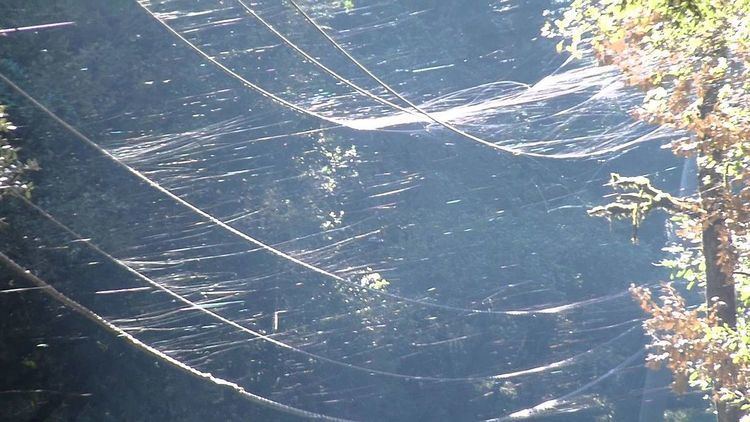 | ||
Ballooning, sometimes called kiting, is a means by which spiders, and some other small invertebrates, can move through the air by releasing one or more gossamer threads to catch the wind. By this means they are wafted aloft and are at the mercy of the air currents. This procedure is mostly used by spiderlings to disperse, but larger individuals have been observed using it. The spider climbs to a high point, stands on its toes and points its abdomen to the sky, releasing fine silk threads from its spinnerettes until lift off occurs. Journeys achieved vary from a few metres to hundreds of kilometres. Even atmospheric data have collected samples of balloons at five kilometres above the earth and ships in mid-ocean have reported spider landings. Mortality is high.
Contents
Description
Ballooning is a behaviour in which spiders and some other invertebrates use air-borne dispersal to move between locations. A spider (usually limited to individuals of a small species), or spiderling after hatching, will climb as high as it can, stand on raised legs with its abdomen pointed upwards ("tiptoeing"), and then release several silk threads from its spinnerets into the air. These automatically form a triangular shaped parachute which carries the spider away on updrafts of winds where even the slightest of breezes will disperse the arachnid. The Earth's static electric field may also provide lift in windless conditions.
Many spiders use especially fine silk, called "gossamer" to lift themselves off a surface, and silk also may be used by a windblown spider to anchor itself to stop its journey. The term "gossamer" is used metaphorically for any exceedingly fine thread or fabric. Biologists also apply the term "balloon silk" to the threads that mechanically lift and drag systems.
It is generally thought that most spiders heavier than 1 mg are unlikely to use ballooning. Because many individuals die during ballooning, it is less likely that adults will balloon compared to spiderlings. However, adult females of several social Stegodyphus species (S. dumicola and S. mimosarum) weighing more than 100 mg and with a body size of up to 14 millimetres (0.55 in) have been observed ballooning using rising thermals on hot days without wind. These spiders use tens to hundreds of silk strands, which form a triangular sheet with a length and width of about 1 metre (39 in)
In Australia, in 2012 and in May 2015, millions of spiders were reported to have ballooned into the air, and landing, making the ground seem like snow covered the ground with the white spiderwebs.
Distance and height achieved
Most ballooning journeys end after just a few meters of travel, although depending on the spider's mass and posture, a spider might be taken up into a jet stream. The trajectory further depends on the convection air currents and the drag of the silk and parachute to float and travel high up into the upper atmosphere.
Many sailors have reported spiders being caught in their ship's sails, over 1,600 kilometres (990 mi) from land (Heimer 1988). They have even been detected in atmospheric data balloons collecting air samples at slightly less than 5 kilometres (16,000 ft) above sea level. Evidently, it is the most common way for spiders to invade isolated islands and mountaintops. Spiderlings are known to survive without food while travelling in air currents of jet streams for 25 days or longer.
Some mites and some caterpillars also use silk to disperse through the air.
Ballooning spiders can land on water and survive afloat. Their water-repellent legs keep them alive on both fresh and salt water enable them to survive waves up to 0.5 millimetres in height. In wind spiders could raise their legs or abdomens to use as sails, propelling themselves across the water's surface. The spiders drop silk to anchor themselves in place while afloat. Said spiders did not show these behaviours on land, suggesting that they are adaptations to water.
